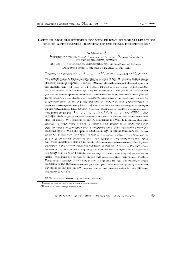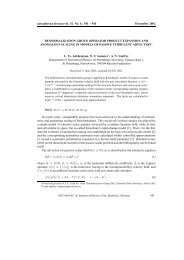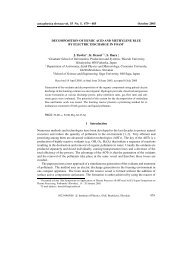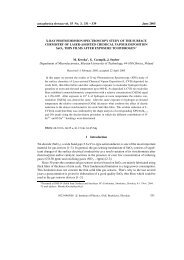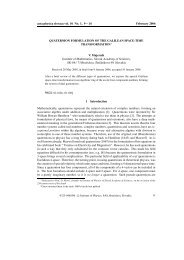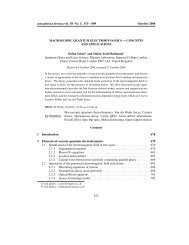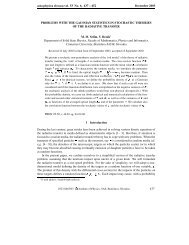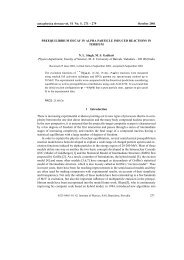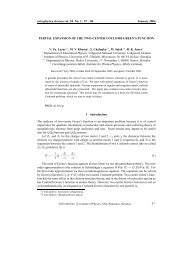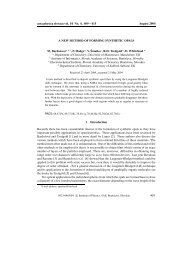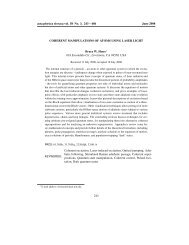Two-pulse spin echo in two-level systems inside ... - physics.sk
Two-pulse spin echo in two-level systems inside ... - physics.sk
Two-pulse spin echo in two-level systems inside ... - physics.sk
You also want an ePaper? Increase the reach of your titles
YUMPU automatically turns print PDFs into web optimized ePapers that Google loves.
66 L. L. Chotorlishvili et al.<br />
be limited by the condition γ n η 0 H 1 > |ω nd − ω nw | = α, which guarantees the TLS excitement<br />
along the whole Bloch walls. Here H 1 is the amplitude of radio frequency field, γ n is the<br />
gyromagnetic ratio for nuclei, η 0 is the value of the enhancement coefficient η(y) <strong>in</strong> the center<br />
of 180 ◦ Bloch wall. Let us expla<strong>in</strong> our assumption briefly. As it was already mentioned, we<br />
consider the case when TLS atoms are magnetic. Therefore, the matter of particular <strong>in</strong>terest<br />
for us is the dipole-dipole <strong>in</strong>teraction between the <strong>sp<strong>in</strong></strong>s of these atoms and the electron magnetic<br />
moments form<strong>in</strong>g the ferromagnetic structure of the material (doma<strong>in</strong>s and Bloch walls).<br />
The fluctuation of the dipole-dipole <strong>in</strong>teraction constant caused by atom transition between TLS<br />
states allows TLS pseudo-<strong>sp<strong>in</strong></strong> to experience the action of external magnetic field (static or variable).<br />
Let us consider that M ⃗ i = γ s ⃗s i is the magnetic moment of the atom located <strong>in</strong> i-th TLS (γ s<br />
is the gyromagnetic ratio and ⃗s i is the <strong>sp<strong>in</strong></strong> operator for electrons). The dipole-dipole <strong>in</strong>teraction<br />
H dd<br />
(<br />
= A<br />
)<br />
1 ⃗Mi ⃗<br />
rij 3 Mj between the magnetic moment M ⇀ i and electronic magnetic moments<br />
located <strong>in</strong> doma<strong>in</strong> wall changes due to the fluctuation of the <strong>in</strong>ter-atomic distance r ij caused by<br />
tunnel<strong>in</strong>g of i-th atoms from one state to another<br />
⎛ ⎛<br />
⎞<br />
A ⎜<br />
1<br />
(<br />
⎝<br />
r ij + d ) 3 ⎟ 0<br />
⎠<br />
H dd =<br />
2 ⎛<br />
⎜ 0 A ⎜<br />
1<br />
⎝<br />
⎝<br />
(<br />
r ij − d 2<br />
⎞<br />
⎞<br />
⃗M iMj ⃗ ,<br />
) 3 ⎟⎟<br />
⎠⎠<br />
where d is the distance between the states of i-th TLS, A is the dipole-dipole <strong>in</strong>teraction constant.<br />
Expression for H dd can be expanded <strong>in</strong> series <strong>in</strong> terms of the small parameter<br />
d<br />
r ij<br />
∼ 0.1.<br />
Tak<strong>in</strong>g <strong>in</strong>to account the l<strong>in</strong>ear term of this expansion we obta<strong>in</strong> the follow<strong>in</strong>g expression for the<br />
frequency of i-th TLS<br />
ω ′ i = E′ i<br />
¯h<br />
= ⎛<br />
⎝E i /¯h + 3d<br />
r<br />
∑<br />
j<br />
A ij<br />
⃗ Mi ⃗ Mj<br />
⎞<br />
⎠ d z i ,<br />
where d z i is the pseudo-<strong>sp<strong>in</strong></strong> operator of TLS, E is the splitt<strong>in</strong>g energy. When the l<strong>in</strong>e width of<br />
TLS caused by Klauder-Anderson mechanism is ∆ω ∼ 10 6 Hz, the magnitude of 3d<br />
r Aγ2 s ∼<br />
0.3 · 10 9 Hz shows that the given mechanism is effective. External magnetic field <strong>in</strong>fluences the<br />
TLS frequency by means of the <strong>in</strong>teraction with magnetic moments of electron <strong>sp<strong>in</strong></strong>s. (The direct<br />
<strong>in</strong>fluence of the external magnetic field on the magnetic moments of i-th atom, presented <strong>in</strong> the<br />
i-th TLS, does not affect the frequency of this i-th TLS. This <strong>in</strong>fluence on frequency becomes<br />
apparent <strong>in</strong> other TLS, when the magnetic moments of the given i-th TLS play the role of external<br />
electron moments.) Let us consider the <strong>in</strong>fluence of external variable field on the frequency of<br />
<strong>two</strong>-<strong>level</strong> system <strong>in</strong> detail. The variable field changes the orientation of δM electron magnetic<br />
moments. These moments take the orientation along the effective field<br />
H = H 0 + h(t) ,<br />
where H 0 is the static magnetic field and h(t) is the variable field.



